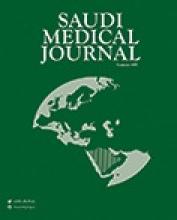To the Editor
The diagnosis of juvenile-onset systemic lupus erythematosus (SLE) is often delayed because it presents with a variety of non-specific symptoms and signs. It is a serious illness causing significant morbidity, delay of normal growth and development and increased mortality.1 Early diagnosis and prompt treatment lead to a better outcome. The study by Nazri et al2 on SLE, though retrospective with a small number of patients, it reemphasizes that the majority of children with SLE (65.5%) present with glomerulonephritis but only 28% have malar rash, 22% have oral ulcers, 16% have prolonged fever, and 13% have arthritis. Pleurisy and alopecia, more common in adult-onset SLE were rare. A high degree of awareness is needed in children who present with constitutional symptoms such as fatigue, prolonged low grade fever, joint pain and a malar erythema. Examination of the urine is simple and may help with an early diagnosis. The presence of pyuria, hematuria and proteinuria is highly predictive of the presence of nephritis. A positive antinuclear antibody (ANA) test confirms the diagnosis. In Nazri’s series, all of their patients (100%) had a positive ANA and low complement levels indicating active disease. A biopsy is necessary to determine the histological type; proliferative glomerulonephritis (Type IV) is the most common in this series. A significant observation in this study is the association of active disease with the presence of mouth ulcers, malar erythema and a raised erythrocyte sedimentation rate (ESR). Examination of the mouth, looking for ulcers, is imperative. Low grade fever is a significant finding in patients with SLE (36% to 86%) yet it is not included in the current published classification criteria for SLE.3,4 There is a suggestion that fever will be included in the as yet unpublished new classification criteria proposed by the American College of Rheumatology (ACR)/European League Against Rheumatism (EULAR) criteria for SLE.5 Though Malaysia is multi-ethnic, the cohort in this study is of Malay-origin because 95% of the population of Kelantan state are Malay. This fact adds to the strength of the study. Another interesting observation from the study is that low complement 4 (C4) with normal complement 3 (C3) is not associated with active disease because low C4 is associated with the B8, DR3 haplotype, which predisposes to the development of SLE and is present in 80% of patients. Low C3 and low C4 signifies activation of the complement system by immune complexes. Normal C4 with low C3 indicates activation of the immune system via the alternative pathway which only occurs in a small number of cases. (Table 1).
Clinical interpretation of complement 3 and 4 levels.
The term juvenile-onset SLE is currently preferred to pediatric SLE.2 There is an inadequate evidence for therapeutic intervention specific to juvenile SLE. Treatment is based on evidence from disease in adults and small case series. A multi-centre therapeutic intervention trial is much needed. The study by Nazri et al adds significant information to the literature on Juvenile-onset SLE.
Reply from the Author
We greatly appreciate your valuable comments and agree with most of what has been commented pertaining to our published article. We concur with the views that more emphasis should be given to constitutional symptoms including fever. Although fever is non-classical and represents a less specific manifestation, it is vital to distinguish early SLE. In out cohort of pediatric SLE patients, a lack of statistical significance was shown between fever and SLEDAI score (p=0.052) but fever was present in nearly one-fifth of the cohort. We look forward to the new version of ACR/EULAR criteria for SLE. Currently, we are referring to 1997 ACR criteria, with regards to the terminology used. Silva et al6 (2012) have described that childhood onset or pediatric lupus/juvenile SLE is similar and interchangeable. Again, we really appreciate your expert opinion regarding the preferred term to use in the future.
Wan Zuraida W. A. Hamid
Department of Immunology School of Medical Sciences Universiti Sains Malaysia Kelantan, Malaysia
- Copyright: © Saudi Medical Journal
This is an open-access article distributed under the terms of the Creative Commons Attribution-Noncommercial-Share Alike 3.0 Unported, which permits unrestricted use, distribution, and reproduction in any medium, provided the original work is properly cited.






